Morsa Images/DigitalVision via Getty Images
As a business owner, who has served thousands of customers through Shopify myself and began my entrepreneurial journey on the platform in 2018 when Shopify Inc. (NYSE:SHOP) was still a small business, I can’t be grateful enough for the services they have provided me. So you might want to keep that in mind, as I may have some bias toward the company.
That being said, in this article I will explain through the lens of a business owner why the stock price presents significant opportunities for long-term investors, after a 75% decline in share price, with the upcoming first quarter results in mind.
How I Ended Up With Shopify
Shopify is an online e-commerce platform for online stores and retail businesses. When I started my very first business in e-commerce in 2018, I was looking for the best and most effective way to launch my business that sold products B2C mainly to customers in North America. I worked with Shopify for 2 years, after which I decided to move platforms to WooCommerce due to the high transaction fees with the integration of Stripe/ PayPal (PYPL) and Shopify, which together took almost 5% in transaction fees.
However, this was a decision I ended up regretting deeply. Since every other alternative I looked for just didn’t have the versatility that Shopify offered. Either their customer service was too poor, the interface was too confusing, they had no integration with other developers/ companies/ apps, so on and so forth. So a few months later I decided to migrate back to Shopify, despite the higher cost. A few years later, Shopify launched Shopify Payments in Belgium, which solved the high transaction fees, and I’ve never looked back since.
The Shopify Ecosystem (Shopify IR)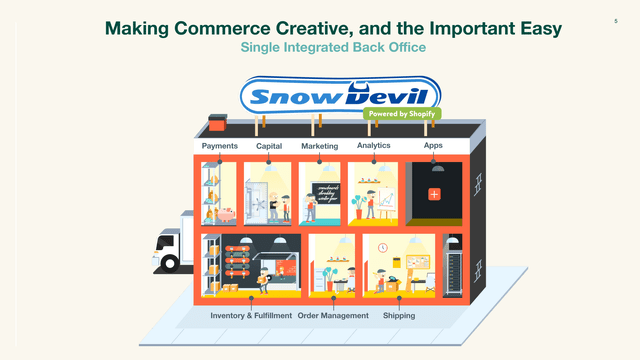
After almost 5 years of seeing and using Shopify’s products and services, and talking to many other business owners and entrepreneurs, I can testify that they too can’t live without the platform and it’s integrations.
Customer Care
Because I’ve been working with Shopify for years and years, I can attest first-hand to their customer service over the years, and offer a unique perspective on what I’ve seen. Shopify has, without a doubt, one of the fastest, most constructive and insightful customer service experiences I have ever experienced across all departments.
It felt like they were taking a chapter out of Amazon’s (AMZN) book on “customer obsession.” I can even recount a full conversation with support in 2020 where one of the representatives gave feedback and actually converted into a customer after I contacted them for experiencing some issues with Shopify Payments leading up to a launch.
Shopify Customer Support Encounter 2020 (Logged Chat from Author)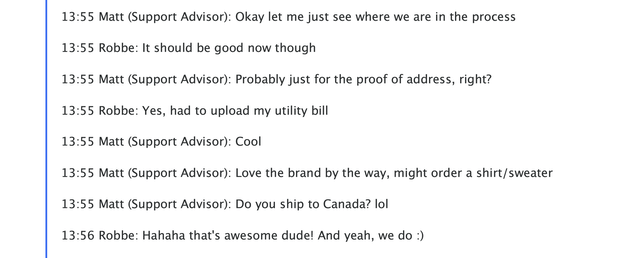
Shopify’s USP and Market Share
Some may argue that Shopify’s stock price has fallen so much because it is in the later stages of growth, as a result of less exponential revenue growth. For example, between 2013 and 2015, Shopify saw triple-digit growth, nearly 100% YoY, compared to 57.43% YoY in 2021. Critics also like to cite the high P/S ratio of 12.85 or a forward P/E ratio of 185.19.
I generally believe these multiples are justified, just as Tesla’s (TSLA) high/ negative P/E ratio has been justified, and offset by the nature of its high revenue growth + rising margins / product expansion. It is my firm belief that Shopify will likely continue to garner market share by first allocating capital, establishing a network, and only later monetizing this vast customer base, as Amazon did by banking on other more profitable products. Amazon for example, reported an operating margin of 35.3% for its AWS Segment this week.
Shopify’s New Product Adoption (Shopify IR)
To give investors some additional context, I believe Shopify is in the early stages of its growth. Retail e-commerce sales account for a US$4.92T market worldwide, which is expected to grow to US$7.39T in the next 5 years, at a CAGR of 10.70% for the entire industry worldwide. Shopify is aggressively winning market share, with revenue growth of 79.62% CAGR between 2012 and 2021.
As far as I can tell, Shopify’s Unique Selling Point still remains its robust ecosystem, which offers flexibility in terms of inventory management, applications created by developers, convenient UI, good customer support, and store integration both online and offline (Retail POS). This ecosystem is expected to expand further as Shopify moves toward robust fulfillment integration, possibly even with the acquisition of Deliverr.
Shopify’s Plan (Shopify IR)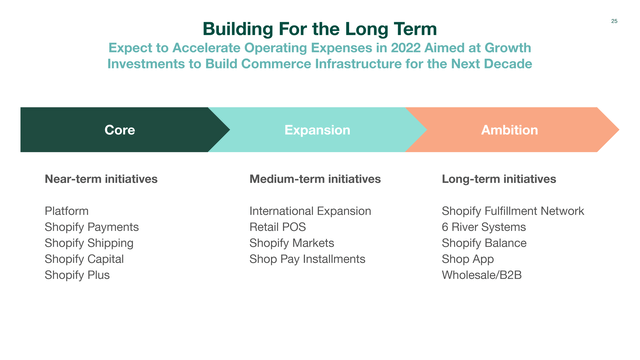
These types of integrations will further tie business owners to the platform, and lower the bar for new business owners to start a business with Shopify. Meanwhile, Shopify is also expanding their financial and Artificial Reality side of the business, with opportunities to not only compete with Amazon, but also with Google (GOOG) Payments and Apple (AAPL) Pay, introducing their own ecosystem.
Financials Ahead of Earnings
Since I am not just a small business owner, it is of course of utmost importance to look at the financial side of the business, taking into account the 10-K, as I believe that at the end of the day, every business valuation comes down to Free Cash Flow and Enterprise Value.
The outlook for the company has become very bleak, as evidenced by its share price, which has fallen more than 65% in the past year. On top of that, even for the first quarter, Street Estimates predict a significant drop in revenue, to $1.24BN, compared to $1.38BN in the fourth quarter of 2021. Analysts even predict a large drop in net income and FCF, likely due to higher operating costs and new investments.
Net income is expected to fall to $83.55M in the first quarter from $172.84 in the fourth quarter of 2021. FCF is expected to dip into negative territory, -$49.65 for Q1 2022, versus $234.48 in Q4 2021.
Shopify Key Fundamentals (TIKR Terminal)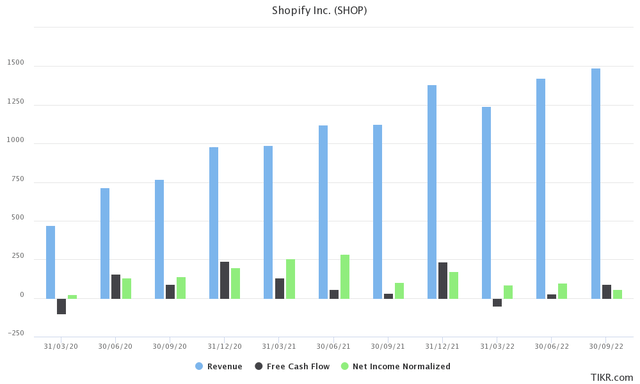
Two analysts from Loop Capital and Wedbush also lowered their price targets this week. Wedbush lowered their price target to $630, down $937. Loop Capital sees it more bearish and lowered their price target to $460, down $660, making it currently the most bearish price target on the Street.
The move came days after rival Amazon’s shares plunged more than 15%, after reporting an unexpected first quarter loss and the lowest revenue growth since 2001. In terms of Shopify’s forecast, you can see in the chart below that analysts have been notoriously wrong in Shopify’s EPS and revenue predictions, underestimating its revenue target by 10% to the downside.
Shopify Revenue Growth Actual v. Consensus (Seeking Alpha) Shopify EPS Actual v. Consensus (Seeking Alpha)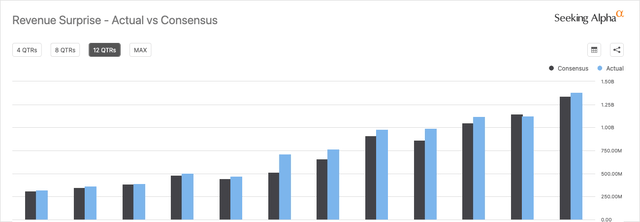
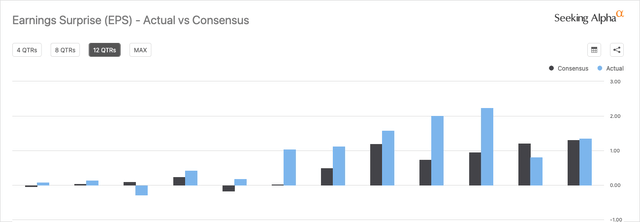
Why Shopify Is Cheap
In 5 years, in 2027, I expect Shopify to continue its aggressive revenue growth, with a CAGR of 45% and reach revenues of nearly $30BN. In January 2022, NYU Stern reported that the P/S ratio for Online Retail is 3.35. I expect Shopify to continue to show strong revenue growth through 2030, and thus a higher P/S ratio closer to 4. At a P/S ratio of 4, and $30B in revenue, Shopify would trade at a market cap of $120BN or $953.12 per share on a non-diluted basis.
That would account for a CAGR of 15.43% in terms of price growth, which provides plenty of excess alpha compared to broad-based benchmarks. This price target likewise does not take into account any meaningful growth in gross margins or operating margins, although Shopify has seen meaningful progress in margin growth. Shopify’s operating margins were 6.5% in 2021, compared to -8.9% in 2019, despite showing strong revenue growth, as mentioned earlier.
Investors should also recognize that Shopify is still in the early stages of growth, compared to competitors such as Amazon, and thus is more likely to exhibit higher operating costs that can be attributed to one-time investments.
Shopify’s Strategic Plan (Shopify IR)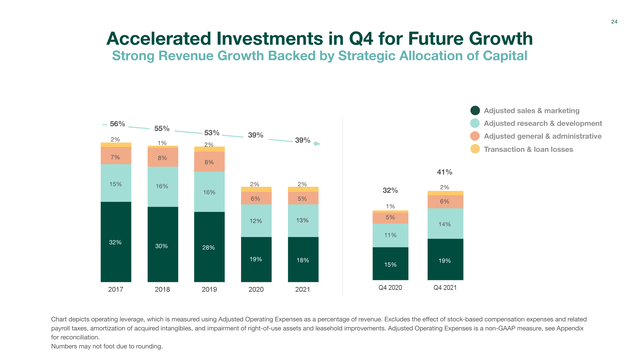
Shopify’s actual share price could be much higher than US$953.12 in 2027, if management is able to sustain growth, gain market share and continue to bring innovative products to increase margins, such as the Shop App and additional services such as Shopify POS and an expanded fulfillment network.
All Equities Have Some Downside
Since I cover innovative stocks, I have a long-term investment horizon. Although Shopify could experience a rebound after reporting earnings, which provides short-term gains, I expect Shopify to experience heightened volatility. As mentioned above, since the stock is still trading at a high price-to-earnings ratio, the stock could fall even further if the macroeconomic backdrop of high inflation and the Fed’s woes become even more precarious.
As Ben Graham used to say:
In the short run, the market is a voting machine but in the long run it is a weighing machine.
In terms of competition, Shopify faces both large competitors like Amazon, Walmart (WMT), eBay (EBAY), Apple, and smaller competitors in its niche like Wix.com (WIX), Square Online (SQ) and Squarespace (SQSP).
Shopify Competition (Shopify IR)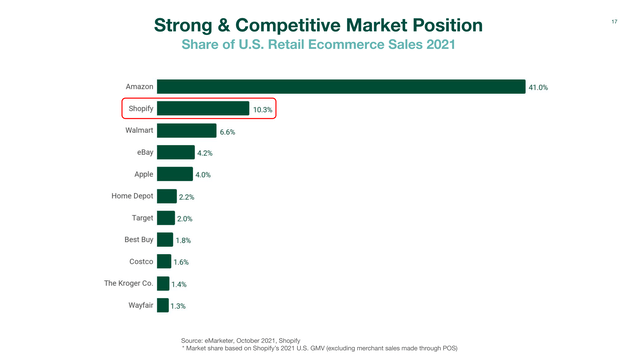
Where is Shopify Headed?
Based on my perspective, I think Shopify has hit its bottom. This view comes as I think uncertainty is at an all-time high and the outlook is the most bearish in a long time on macroeconomic factors such as: an inverted yield curve, high inflation growth, questionable Fed policies and a slowdown in global GDP growth. This is especially reflected in, for example, the Bull-Bear Spread at -42.92%, the worst sentiment in decades and even worse than the 2008 financial crisis, which is inherently bullish.
Bull-Bear Spread, US Investor Sentiment (YCharts)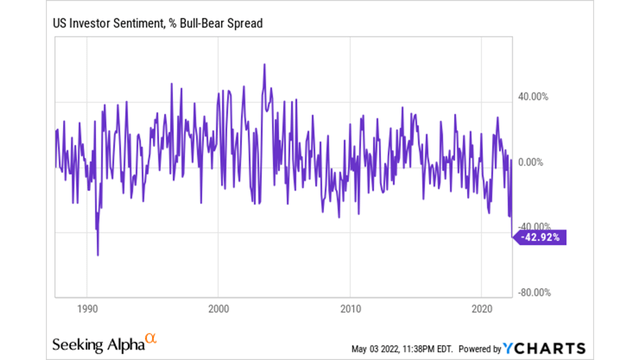
Over the years, every successful venture I have undertaken would not have been possible without Shopify’s flexibility and integrations, as many other entrepreneurs told me they could not run their business without the platform, similar to how consumers are locked into the Apple Ecosystem.
I think investors underestimate the potential that Shopify has, and the growing ecosystem that offers value to almost every small and medium-sized business worldwide, and their ability to monetize this ecosystem and increase margins.




